Māori and the Marists (3)
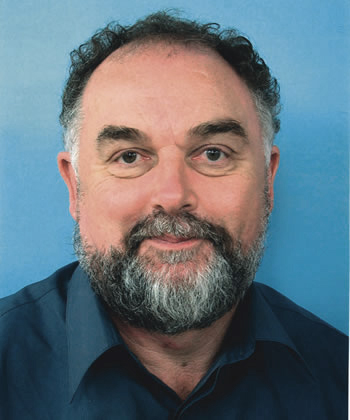
by Ken Scadden
Records of a 175 year relationship
The MM is grateful to Archifacts, the magazine of the Archives and Records Association of New Zealand (ARANZ), to Theresa Graham, ARANZ president, and to Ken Scadden, for permission to reprint this article. Ken died on 17 October this year. R.I.P.
The principal Māori Missions on the West Coast of the North Island were at Hiruharama (Jerusalem) and Pukekaraka (Ōtaki).
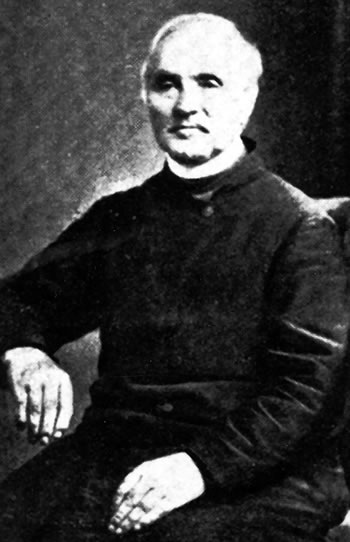
Fr Lampila sm
Father Lampila (Hone Rapira) arrived in Whanganui in 1852 and tradition has it that he was tacitly supported by Te Pehi Turoa, the principal rangatira (chief)on the river, who had strong links with the Waikato and Taranaki. Together with Brother Elie Regis they built flour mills along the river. There was a suspicion in Government at this time that there was a connection between papists and disloyalty to the British Crown. Father Lampila was even accused of raising the French flag on the river and had to face a Government inquiry.
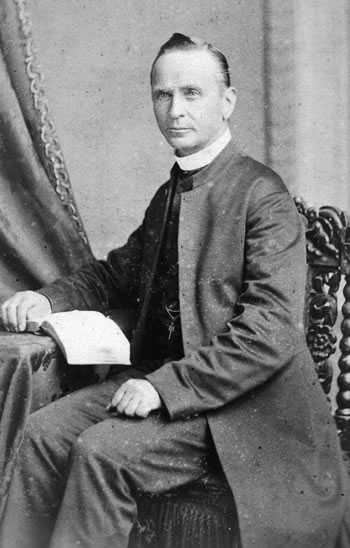
Fr Rolland sm
During the Land Wars, Brother Euloge was killed at the battle of Moutoa Island on the Whanganui River while supporting his congregation. Father Rolland came in for praise for his courage in tending the wounded during a battle and had a bullet-hole shot in his hat.
The principal Māori Missions on the West Coast of the North Island ... Hiruharama and Pukekaraka
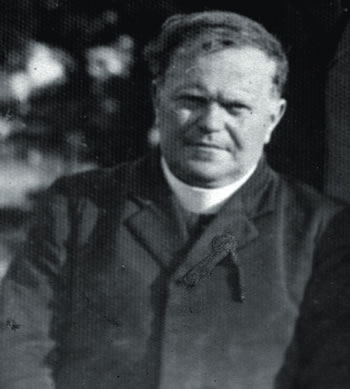
Fr Vibaud sm
Father Jean Marie Vibaud (Pā Wiripo) was a Marist priest who spent seven years from 1907 to 1914 at Hiruharama on the Whanganui River and another four years in Whanganui itself. Such was the respect that he gained, he was inducted into the Whare Waananga (equivalently a university) on the river. His writings have been used in several books and in claims by iwi to the Whanganui River.
An entry in his notebook reads:
Canoes were the only way of access to the Whanganui fastness. And to this day one may see in the soft papa cliffs the holes made by the poles of successive generations of canoe polers. With the advent of European steamers the native canoe was abandoned and the poling holes became the convenient homes of kingfishers and river ducks. And the present day Whanganui Māori still watches the ancient poling holes during the nesting season. Indeed the River-bank nesting birds have an uncanny way of foreseeing the height to be reached by the highest spring flood. Year after year thus flood height varies and year after year, the nests are built accordingly.
Thus the people of the river were amazingly able to predict the behaviour of the river for the coming winter and spring.
Records in the Marist Archives include correspondence and notebooks from Father Vibaud on aspects of Māori history, language, lore and teachings, mission history and education. It is understood by the Marists that books containing certain sacred information were consigned to the waters of the Whanganui River by Father Vibaud when he left the river for good.
Pukekaraka / Ōtaki
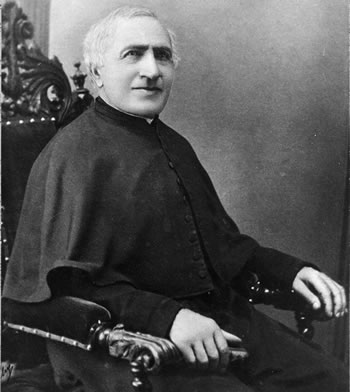
Fr Comte sm
Arguably the most successful of the early Catholic Māori Missions was that established in 1842 at Pukekaraka Marae in Ōtaki. The first church at Pukekaraka, also known as Puke Karakia - Hill of Prayer, was built in 1844 by Father Comte (Pā Kometa).
Father Comte, like all Marists, was not interested in acquiring land, but in education and evangelisation, and worked hard to raise his congregation’s standard of living. He introduced flour mills, rope making equipment, and bullock drays, and encouraged trade by acquiring a schooner, the Elizabeth, for them to convey their produce to Wellington. This vessel made a number of voyages to and from Wellington during 1853-1854, including at least one commanded by a Māori captain named Terawatu.
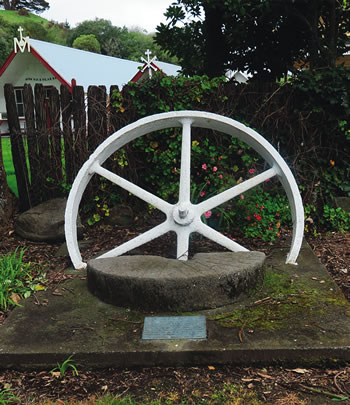
The plaque reads: This wheel and stone were once part of the Pukekaraka flour mill erected about 1854 under the direction of Father Comte s.m. The mill stood on the bank of the Waitohu River on property now owned by Mr Ray Taylor who donated these remains for erection on the site of the Pukekaraka Mission. Otaki Historical Society Inc. 1985
When Father Comte went back to France in 1854 lack of personnel and resources to maintain the Mission Station caused a decrease in ministry in the Māori Mission. Within a few years the church was burned down, and although a new church was built in 1859, there was no resident priest available and Marist priests tried to service it from Thorndon, Wellington.
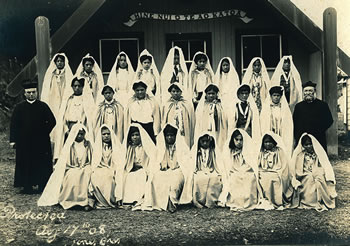
Frs Vibaud and Cognet with Children of Mary outside Hine Nui o te Ao Katoa, Otaki, 1908
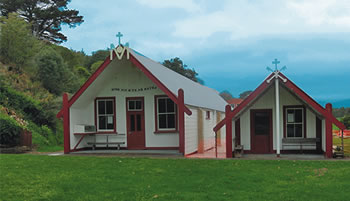
The meeting houses Hine Nui o te Ao Katoa and Roma, 2016
Pukekaraka’s fortunes were not revived until Father Melu (Pā Werahiko) took up residence in Otaki in 1883.
‘Roma,’ the first wharenui, was built in 1904. The catechists of the time were Te Aomarere, Te Pokaitara, Te Hiakai, Taiaroa, Tutuohe (of Ngapuhi) and Hakaria Rangikura. Hakaria rang the church bell for over 40 years and the bell in the Otaki Church is still named Te Pere O Rangikura in his honour.
The larger wharenui, ‘Hine Nui O Te Ao Katoa,’ was built in1905. Hine has no carvings but has a special Ko-whai-whai pattern done for her. Hine has been used for a number of tangi; the Māori Women’s Welfare League, the Catholic Women’s League and the school whānau (family) all still use her for meetings.
These wharenui were built during the time of the great hui of Father Delachienne (Pā Hohepa).
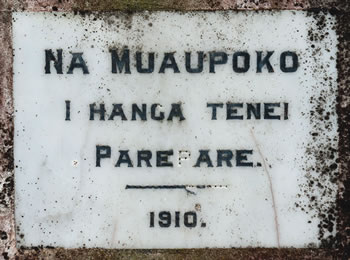
"Muaupoko built this wall. 1910."
The Parepare - Wall of Reconciliation - was built by the Muaupoko iwi (people) in 1910. As Muaupoko had a great influence on the development of Pukekaraka the marae and meeting houses were used by both Ngati Raukawa and Muaupoko.
As a result of the long association with Pukekaraka the Marist Archives hold extensive records of Marist work there including correspondence, photographs, baptism, marriage and burial records - dating back to 1844.
 Entries(RSS)
Entries(RSS)